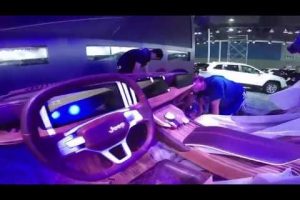While working with the FCA Product Design Office UX department, I was tasked to go to Shanghai to set up interior and exterior displays and networking for the Jeep “Galileo” concept. My goal was to create a solution that kept every display in sync, both on the concept vehicle, as well as on the external large screen HUD and other displays in front of the concept. This all had to happen automatically, activated by one power switch. The Jeep concept display was an elegant blend of modern UX and artistic expression.

To create a setup that required three displays on the property to be in sync with seven others outside of it on other televisions would require some fast networking and syncing. I turned to NodeJS and Socket.IO for the solution. With a bunch of Intel NUC computers, I networked them all together via router and switches. One of the NUCs ran a NodeJS server that would offer lots of control and flexibility to this concept. We were able to control the scenes via a wireless show controller as well (something not easy to do in a RF noisy environment like a tradeshow/autoshow). The show controller could either start a countdown to the show or just proceed between scenes.

This concept was shown at multiple locations including Shanghai, Guangzhou, and Las Vegas. Stage lighting was also synced with the presentation using our audio time-code from one of the computers. I documented the Shanghai Auto Show setup in the video above.





